Select Rally Racing combines speed and strategic navigation on challenging off-road tracks. To excel, drivers must master track dynamics, communication with co-drivers, and real-time decision-making using specialized tools, aided by training at dedicated rally schools. This historic sport, with iconic drivers like Colin McRae and Sébastien Loeb, continues to attract professional teams investing in advanced technology and vehicle preparation. Success hinges on a harmonious blend of robust vehicles, skilled drivers, effective communication, and meticulous event planning.
Mastering advanced rally techniques is not just about speed; it’s an art of precision, strategy, and adaptability. In this guide, we’ll take you through the essentials of Select Rally Racing, from understanding the fundamentals to honing your skills in navigation and driving. Learn how to conquer unpredictable terrain with expert turns and cornering, leverage advanced tools for strategic route planning, and gain a competitive edge on special stages.
- Understanding the Fundamentals of Rally Racing
- – Definition and history of rally racing
- – Key components of a successful rally car and driver team
Understanding the Fundamentals of Rally Racing

Rally racing, a thrilling off-road discipline, involves navigating unpredictable terrain at high speeds. To master advanced rally techniques, understanding the fundamentals is crucial. This includes grasping the unique dynamics of select rally racing tracks, learning effective driver-co-driver communication, and honing navigation skills using specialized maps and tools.
The art of rally racing goes beyond just driving fast; it’s about strategic decision-making based on real-time course conditions. A good navigator plays a pivotal role in keeping the driver informed about upcoming obstacles, turns, and changes in road surface. Budget rally racing tips suggest investing time in training with experienced navigators at schools dedicated to rally racing techniques, where you can learn these intricacies and develop a sharp sense of observation, vital for success on any course.
– Definition and history of rally racing

Rally racing, also known as select rally racing, is a thrilling motor sport that has captivated enthusiasts worldwide since its inception. Originating in Europe during the early 20th century, it evolved from informal off-road drives to highly organized competitions, showcasing the performance and reliability of vehicles. The sport involves driving a closed-course route, often through challenging terrain, with a co-driver navigating using a road book. This dynamic partnership requires exceptional communication and quick decision-making skills, making rally racing as much about strategy as it is about speed.
Over the years, rally racing has witnessed numerous historical moments, including iconic victories by legendary drivers like Colin McRae and Sébastien Loeb. It has also seen the rise of professional teams investing heavily in technology and vehicle preparation, transforming the sport into a sophisticated blend of automotive engineering and driver prowess. Furthermore, with dedicated events tailored for veterans looking to relive their glory days, rally racing continues to foster a sense of community among participants, preserving its rich heritage while pushing the boundaries of performance and competition.
– Key components of a successful rally car and driver team

A successful rally car and driver team is a harmonious blend of several key components. First and foremost, the vehicle itself plays a pivotal role in select rally racing. It must be robust, reliable, and designed for both speed and off-road capability. Advanced engineering, including precise suspension systems, powerful engines, and efficient cooling mechanisms, are essential to navigate challenging terrains swiftly. The driver’s skill set is equally critical; they need exceptional hand-eye coordination, quick decision-making abilities, and a deep understanding of the track or trail.
Effective communication between the driver and co-driver is another vital aspect. In off-road rally racing safety, clear communication ensures precise navigation, especially in unfamiliar terrain. The co-driver provides real-time information about upcoming turns, road conditions, and potential hazards, enabling the driver to make split-second adjustments. Furthermore, meticulous event planning, as outlined in a comprehensive rally racing event planning guide, is crucial. This includes understanding local regulations, preparing for varying weather conditions, and knowing the nuances of each stage to optimize performance and ensure a safe finish.
Mastering advanced rally techniques requires a deep understanding of both the sport’s fundamentals and the unique challenges presented by diverse terrains. By selecting the right rally racing equipment, optimizing vehicle setup, and developing sharp driving skills, enthusiasts can elevate their performance in this thrilling discipline. Whether you’re a seasoned racer or just starting, continually refining your craft ensures that every turn becomes an opportunity for improvement and success on the select rally racing circuit.
